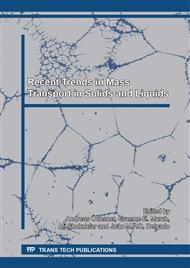p.48
p.55
p.60
p.66
p.72
p.79
p.86
p.92
p.98
Drying of Industrial Hollow Ceramic Brick: Analysis of the Moisture Content and Temperature Parameters
Abstract:
The study of ceramic drying is theme of several researches today. In most case, this research is realized experimentally, making possible measurements errors that reverberating in data slightly out of the expected, or erroneous. Numerical simulation emerges like a tool that allows the reproduction of experiments using computers and suitable software’s. The use of numerical simulation enables fast changes in boundary conditions and help in the improvement of an unit operation. This paper aims to predict the drying process of an industrial hollow ceramic brick using the liquid diffusion model to describe the behavior of the temperature and moisture content inside the brick and drying kinetics along time, with the help of the Ansys® CFX commercial package. Predicted results of the average moisture content and temperature of the brick were compared with experimental results, and good agreements were obtained. It was verified that regions with smaller thickness dry and heat faster than the others.
Info:
Periodical:
Pages:
72-78
Citation:
Online since:
November 2017
Keywords:
Price:
Сopyright:
© 2017 Trans Tech Publications Ltd. All Rights Reserved
Share:
Citation:


